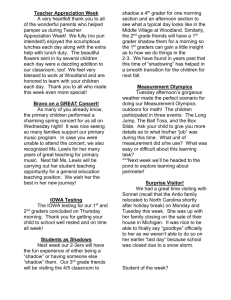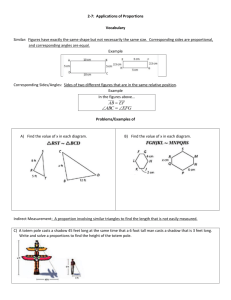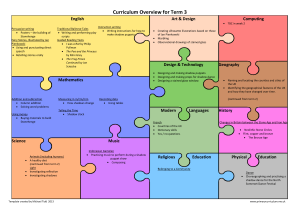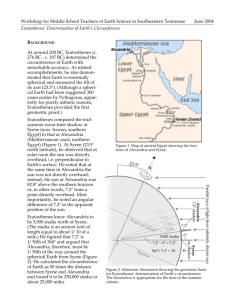Word - Exploratorium
advertisement
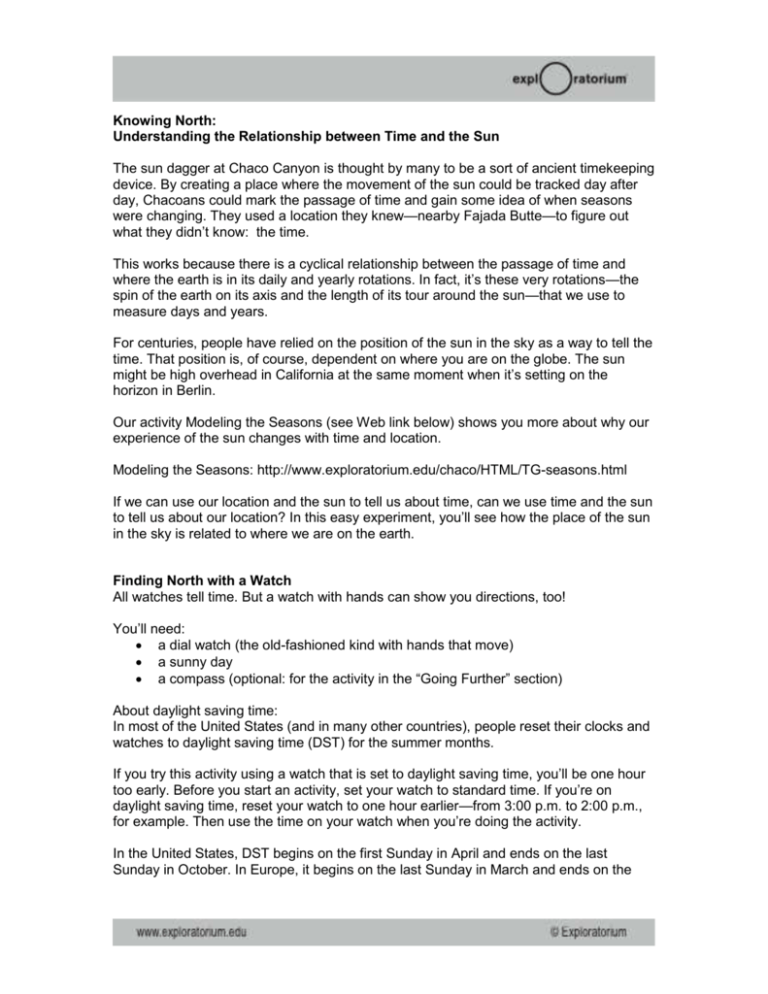
Knowing North: Understanding the Relationship between Time and the Sun The sun dagger at Chaco Canyon is thought by many to be a sort of ancient timekeeping device. By creating a place where the movement of the sun could be tracked day after day, Chacoans could mark the passage of time and gain some idea of when seasons were changing. They used a location they knew—nearby Fajada Butte—to figure out what they didn’t know: the time. This works because there is a cyclical relationship between the passage of time and where the earth is in its daily and yearly rotations. In fact, it’s these very rotations—the spin of the earth on its axis and the length of its tour around the sun—that we use to measure days and years. For centuries, people have relied on the position of the sun in the sky as a way to tell the time. That position is, of course, dependent on where you are on the globe. The sun might be high overhead in California at the same moment when it’s setting on the horizon in Berlin. Our activity Modeling the Seasons (see Web link below) shows you more about why our experience of the sun changes with time and location. Modeling the Seasons: http://www.exploratorium.edu/chaco/HTML/TG-seasons.html If we can use our location and the sun to tell us about time, can we use time and the sun to tell us about our location? In this easy experiment, you’ll see how the place of the sun in the sky is related to where we are on the earth. Finding North with a Watch All watches tell time. But a watch with hands can show you directions, too! You’ll need: a dial watch (the old-fashioned kind with hands that move) a sunny day a compass (optional: for the activity in the “Going Further” section) About daylight saving time: In most of the United States (and in many other countries), people reset their clocks and watches to daylight saving time (DST) for the summer months. If you try this activity using a watch that is set to daylight saving time, you’ll be one hour too early. Before you start an activity, set your watch to standard time. If you’re on daylight saving time, reset your watch to one hour earlier—from 3:00 p.m. to 2:00 p.m., for example. Then use the time on your watch when you’re doing the activity. In the United States, DST begins on the first Sunday in April and ends on the last Sunday in October. In Europe, it begins on the last Sunday in March and ends on the last Sunday in October. Here’s a link where you can find out whether you’re on DST: http://webexhibits.org/daylightsaving/g.html Scroll down to the bottom of the page to find start and end dates for DST around the world. To Do and Notice This way of finding north works anywhere in the Northern Hemisphere. Go outside betw een 6:00 a.m. and 6:00 p.m. and find a place where you cast a shadow on level ground. Make sure your watch is set to the proper time (remember, if you’re on DST, reset your watch to one hour earlier). QuickTime™ and a TIFF (Uncompressed) decompressor are needed to see this picture. Turn your watch so that the hour hand (the little hand) points in the same direction as your shadow. Stand so that one foot lines up with both your shadow and the hour hand. Line up the other foot with the 12 on the watch face. (If it’s before noon, you’ll line up your right foot with the 12. If it’s after noon, you’ll line up your left foot with the 12.) Now your body is facing north. You can also find north by imagining a line that passes from the center of your watch halfway between the hour hand and the 12—this line will point due north. (There are two possible ways to get from the hour hand to 12. Divide the smaller of them with the imaginary line.) What’s Going On? Shadows change as the sun moves. The shadow of a stick standing straight up, for instance, pivots around the base of the stick as the day wears on. (You can find teacher activities related to this idea at the NSTA site, Astronomy with a Stick.) Astonomy with a Stick: http://www.nsta.org/319/ At exactly noon, the stick’s shadow (or your shadow) will point due north because the sun is due south. So even with a digital watch, you can find north at noon. At any other time of day, a shadow is at some angle away from north. The size of the angle changes with the motion of the sun. in the morning, the angle between the shadow and north is large. It gets smaller until noon, when the shadow and north line up. As noon passes, the shadow crosses north, and the angle grows larger again for the rest of the day. The earth rotates at a steady rate. Because the earth is spinning, the sun seems to move across the sky at a steady rate, and the angle of a shadow changes at a steady rate. The earth makes one complete turn, or spin, every 24 hours. A complete spin is 360 degrees. Since it spins through 360 degrees of angle in 24 hours, the earth’s rate of rotation is 360 degrees ÷ 24 hours, which equals 15 degrees per hour. A shadow’s angle away from north changes at that same steady rate. Going Further While you’re outside, make a mark or lay an object on the ground in the direction you’ve found to be north. Then, take out a compass and compare that reading for north with the one you’ve found using the watch. Do the two readings agree with each other? If not, does that mean that one of them is wrong? Unless you’re in one of a small number of places on the globe, you’ll find that the two readings differ slightly. North as indicated by the watch activity is known as “polar north,” “geographical north,” or “true north.” This is the direction toward the North Pole, the northernmost point on the planet. If you were to stand on the North Pole while the earth rotated on its axis, you would remain in the same place while the earth south of you spun in a circle. Your compass, on the other hand, is showing you “magnetic north,” which is the direction of the earth’s magnetic pole. This actually lies 700 miles from the North Pole, in the Queen Elizabeth Islands in Canada. The difference between true north and magnetic north is called “magnetic declination,” and it depends on where you are on the globe. For example, in San Francisco, the declination is 15 degrees east, meaning that your compass will point 15 degrees east of true north. If you only have a compass and you want to adjust the reading for true north, you can find declination for your location at this Web site: http://ngdc.noaa.gov/seg/geomag/jsp/Declination.jsp. Which of the values for north do you think the Chacoans used when constructing their buildings? Why? What other instances in history can you think of where people used the sun to show them true north? Is it more useful for modern ship navigators to use true north or magnetic north? Teacher Tips Grade Level: 3–8 National Standards Addressed Grades 5–8: Earth and Space Science: Earth in the Solar System Science as Inquiry: Design & Conduct Investigation; Analyze & Interpret Data, Develop Explanations, Think Critically Grades K–4: Physical Science: Position and Motion of Objects Physical Science: Earth & Space: Objects in the Sky Physical Science: Earth & Space: Changes in the Earth & Sky Key Concepts Cardinal directions; movement of the sun; rotation of the earth; relationship between time, sun, and location on earth Background Science Geographic versus magnetic north http://en.wikipedia.org/wiki/North_pole Drifting of the earth’s magnetic pole http://www.cnn.com/2002/TECH/space/03/20/north.pole/ History of clocks and timekeeping http://physics.nist.gov/GenInt/Time/early.html Ideas for Discussion Can you explain why it’s day for some people in the world while it’s night for others? How does the sun’s passage across the sky during the day affect where your shadow will fall? The Chacoan people built many buildings to align with the cardinal directions (north, south, east, and west). Why would these kinds of alignments be important to ancient people living in the desert? Going Further Make a sun clock and use the sun’s shadow to tell time http://www.exploratorium.edu/science_explorer/sunclock.html Check for Understanding What will this exercise look like if you try to do it at noon? How would your finding of north be different if you were on daylight saving time and you forgot to set your watch back an hour?




